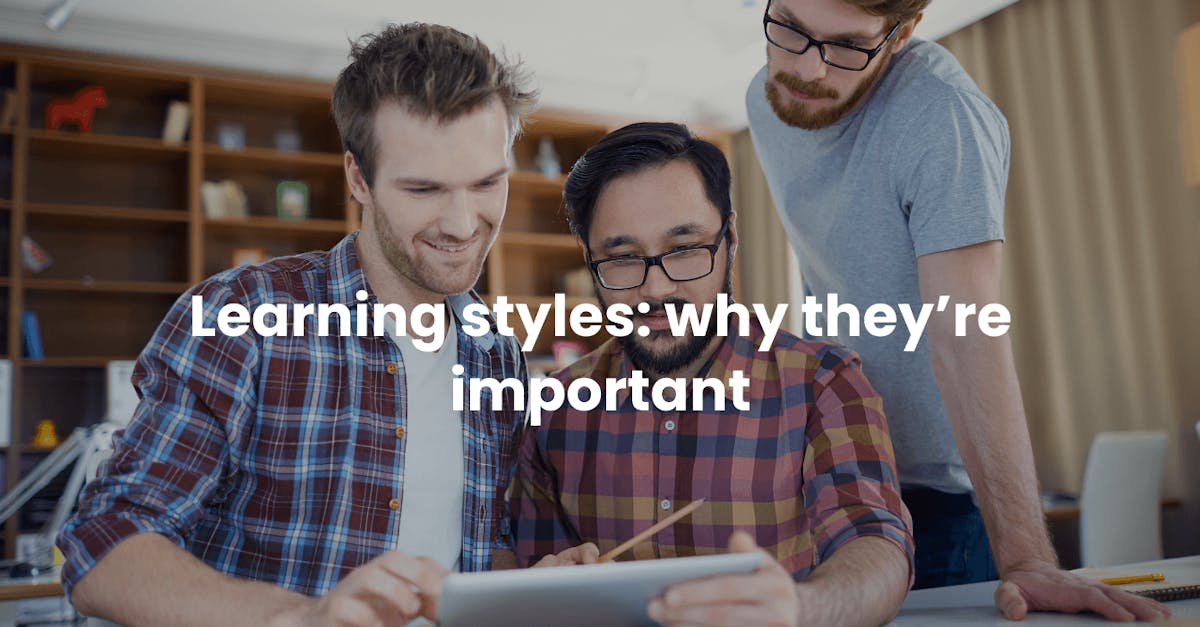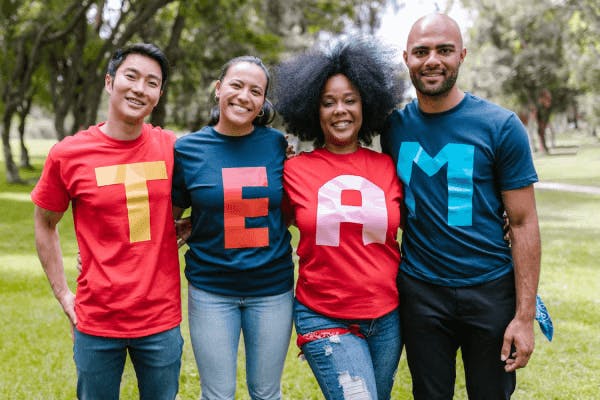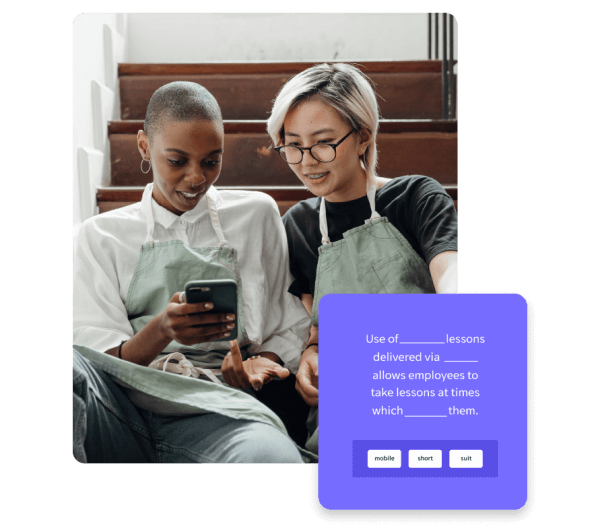Learning styles: why they’re important in learning and development

Learning styles are the various ways in which people learn and process information. They can impact how your learners understand, retain, and apply new knowledge. That’s why understanding their learning styles can help improve the learning process and ultimately lead to better performance.
The importance of identifying learning styles in learning and development
When it comes to learning and development, identifying learning styles should be one of the few things to do before delivering any training program. This is because it helps tailor the learning experiences of your learners to suit their unique preferences. When learners are taught using a method that aligns with their learning style, they tend to understand the material better and retain the information for a longer period of time. This leads to better performance, increased motivation, better employee engagement, and higher confidence levels.

Additionally, identifying learning styles is crucial in a fast-paced workplace and in a competitive market where employees are required to learn new skills and processes regularly. Understanding how an individual learns best can help organizations like yours create more effective training programs and increase employee productivity and job satisfaction.
How effective are learning styles?
The effectiveness of learning styles has been a topic of debate among trainers and researchers. Some studies have suggested that catering to different learning styles can improve learning outcomes, while others have found no significant impact.

One issue with the concept of learning styles is that there is no clear consensus on how to define or measure them. There are many different models and theories of learning styles, and they often lack empirical support.
Another thing to note is that some studies have found that learners can benefit from exposure to a variety of teaching methods, regardless of their preferred learning style. This suggests that rather than focusing exclusively on catering to specific learning styles, trainers should aim to offer a range of teaching methods that can appeal to different learners.
Despite these debates, it’s still important to recognize that learners do have different preferences and needs when it comes to learning. Instructional designers should strive to create a learning environment that is inclusive and caters to the diversity of learners in their classrooms.
Different types of learning styles
There are different learning styles, and your learners can even have a combination of more than one. Some of the most common learning styles include visual, auditory, kinesthetic, tactile, and social learning.

Visual learning
Visual learning is a learning style where people learn best through visual aids such as images, diagrams, graphs, videos, and other visual representations. Visual learners tend to remember information better when it is accompanied by visual aids, as they can process and organize information more effectively in this format. They may also benefit from color coding, mind maps, and other visual tools to help them understand complex information.
Auditory learning
Auditory learners thrive in training sessions that present information through classroom-type lectures, discussions, podcasts, and audiobooks. They recall knowledge better when delivered verbally because they can listen and repeat it to themselves. Group conversations and vocal repetition may also help them grasp difficult topics.
Kinesthetic learning
Physical exercises and hands-on encounters help kinesthetic people learn best. They enjoy activities such as role-playing, experiments, and practical tasks that involve movement and touch.
Tactile learning
Tactile learners have a preference for learning through touch and prefer activities that involve handling objects or materials. They enjoy activities such as building models or creating art. They can also benefit from role-playing, simulations, and other physical activities to help them understand complex information.
Social learning
Social learning is a learning thinking style where your learners acquire and retain information more effectively through social interaction with others. Those who prefer social learning may struggle when learning in isolation, but thrive when collaborating with others, sharing ideas, and learning from peers.
Social learners tend to better remember information when they can discuss and work through problems with others. Collaborating with others can offer multiple perspectives and a deeper understanding of the material.
How to identify your learners' learning style

Identifying the learning styles of your learners can help you design effective learning experiences that cater to their preferences and needs. Here are some methods you can use to find out what their learning preferences are:
- Surveys and Questionnaires: You can ask your learners to complete surveys or questionnaires that assess their learning preferences. These surveys may include questions about how they prefer to receive information, their preferred learning activities, and their strengths and weaknesses.
- Observation: You can observe your learners in various learning activities to identify their preferred learning styles. For example, if a learner prefers to take notes during lectures or discussions, they may be a reading and writing learner.
- Interviews: You can conduct interviews with your learners to learn more about their learning preferences and experiences. This can help you gain insights into their learning style and tailor your teaching methods accordingly.
- Self-Assessment: You can encourage your learners to reflect on their own learning preferences and style. This can be done through journaling, self-reflection activities, or self-assessment quizzes.
Tips and tricks for training learners with different learning styles

Training learners with different learning styles can be challenging, but there are some tips and tricks you can use to make it more effective. Here are some that we suggest:
- Use a variety of teaching methods: Incorporate a range of teaching methods that cater to different learning styles. This can include visual aids, group discussions, hands-on activities, and audio materials.
- Have options for learning: Offer different options for learners to access information and complete tasks. For example, you can offer written instructions as well as verbal instructions, or allow learners to choose between watching a video or reading a text.
- Cater to different learning speeds: Recognize that learners may have different learning speeds and adjust your training accordingly. For example, you may need to spend more time explaining concepts to visual learners or give extra practice activities to kinesthetic learners.
- Use interactive activities: Incorporate interactive activities such as role-playing, group projects, and quizzes to engage learners and cater to different learning styles.
- Give regular feedback: Give regular feedback to learners on their progress and performance. This can help them identify their strengths and weaknesses and adjust their learning strategies accordingly.
- Create a supportive learning environment: Create a supportive learning environment that encourages learners to ask questions, participate in discussions, and seek help when needed. This is great for making learners feel more comfortable and confident in their learning.
How can EdApp train learners with different learning styles?
EdApp, with its wide range of features and tools, can help you cater to the diverse needs and preferences of your learners. But how can EdApp do that?

- Customization: EdApp allows educators to customize learning content and activities to suit the needs and preferences of learners. You can do this through their intuitive authoring tools that are easy to use and beginner-friendly.
- Accessibility: EdApp is accessible on a range of devices, making learning more accessible for learners. Learners can access learning materials on their mobile devices while on the go, catering to learners who prefer to learn in short bursts.
- Interactive activities: EdApp offers a range of interactive activities such as quizzes, games, and puzzles templates that can cater to different learning styles. You can add these templates to any course on their course library or even to a course you made from scratch.
- Personalized learning opportunities: Not everyone learns at the same pace. This means that some people may need to be refreshed or retrained regularly.
- Peer learning: EdApp also has features for those who thrive with peer-to-peer learning. This includes their in-lesson Discussions tool, where you can open up a floor for discussing hard topics within a course and where your learners can talk about ideas with one another.
EdApp is a mobile learning management system designed for today’s digital habits, delivering more engaging and effective microlearning directly to learners anytime and anywhere.
Sign up for this learning tool today.
Author
Stephanie Escuadro
Stephanie is an eLearning content writer for SC Training (formerly EdApp), a microlearning solution designed for today's digital habits. She creates content about cutting-edge learning technologies and resources to help companies deliver great training experiences. When not absorbed in writing, she spends her time taking care of her dog and binge-watching.
